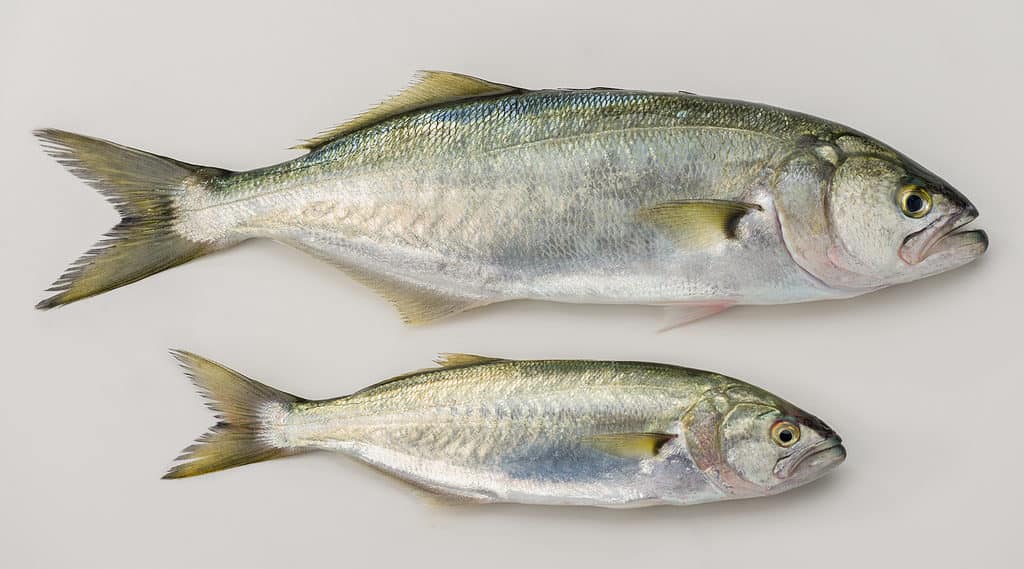Bluefish
Pomatomus saltatrix
Bluefish are known for their "bluefish blitzes," where they chase schools of small baitfish to the surface, creating a feeding frenzy visible from the shore.
Advertisement
Bluefish Scientific Classification
- Kingdom
- Animalia
- Phylum
- Chordata
- Class
- Actinopterygii
- Order
- Perciformes
- Family
- Pomatomidae
- Genus
- Pomatomus
- Scientific Name
- Pomatomus saltatrix
Read our Complete Guide to Classification of Animals.
Bluefish Conservation Status
Bluefish Facts
- Prey
- squid, menhaden, herring, baitfish
- Main Prey
- small school fish
- Name Of Young
- fry
- Group Behavior
- School
- Fun Fact
- Bluefish are known for their "bluefish blitzes," where they chase schools of small baitfish to the surface, creating a feeding frenzy visible from the shore.
- Biggest Threat
- sharks ,tuna, seals and whales.
- Most Distinctive Feature
- two dorsal fins
- Distinctive Feature
- forked tail
- Other Name(s)
- marine piranha
- Predators
- tuna, seals, sharks, whales
- Diet
- Omnivore
- Lifestyle
- School
View all of the Bluefish images!
Bluefish is a predatory saltwater species found in the Atlantic Ocean. It’s known for its fast swimming speed and powerful jaws, allowing it to feed on prey such as smaller fish and squid. Bluefish have a distinctive blue-silver coloration and a torpedo-shaped body and can grow up to 3 feet in length. They are popular among recreational fishermen and commercially harvested for their meat.
Bluefish Fun Facts
- Bluefish are voracious predators and play an essential role in controlling populations of smaller fish and invertebrates.
- Bluefish’s hard-fighting nature and delicious meat make this fish a highly sought-after gamefish.
- They are capable of short bursts of incredible speed, reaching up to 60 km/h.
- Bluefish are known for their “bluefish blitzes,” where they chase schools of small baitfish to the surface, creating a feeding frenzy visible from the shore.
- Marine piranha is another name for the species.
Bluefish Classification and Scientific name
The scientific name of the Bluefish is Pomatomus saltatrix, which belongs to the Pomatomidae family in the order of Perciformes.
Bluefish Appearance

The Bluefish has a lifespan of 10 years.
©iStock.com/kefkenadasi
The appearance of a blue fish has a blue-green to deep blue coloration on its upper body and silver to white color on its belly. They have unique iridescent scales and a streamlined body shape adapted for swimming. Bluefish have a firmly pointed snout, sharp teeth, and a large mouth. The bluefish also has two dorsal fins and a forked tail. They can grow up to 15 to 20 inches in length and weigh up to 31 pounds.
Distribution, Population, and Habitat
Bluefish are widely distributed in the Atlantic Ocean, ranging from the coast of North America to the coast of Europe and Africa. The global population of bluefish is considered to be abundant and stable. They are found in various habitats, including estuaries, nearshore waters, and offshore waters, typically in areas with a strong current and temperatures ranging from 10 to 25°C.
Bluefish Predators and Prey
Bluefish are predatory fish and have a varied diet, feeding on smaller fish, squid, and crustaceans. They are also known to eat on schools of baitfish, such as menhaden and herring. As opportunistic feeders, they feed on a wide range of prey.
Potential predators of bluefish include larger fish species, such as sharks and tuna, plus marine mammals, such as seals and whales.
Bluefish Reproduction and Lifespan
Bluefish reproduction occurs through external fertilization, in which the male releases sperm to fertilize the eggs after the female releases her eggs into the water. This process typically occurs in the spring and early summer in temperate waters, with the adults gathering in large schools for spawning. The fertilized eggs develop into larvae, settling on the bottom and undergoing metamorphosis into juvenile Bluefish.
Bluefish have a fast growth rate and reach maturity in 3-4 years. These fish have a lifespan of approximately ten years and are known to have multiple spawning events throughout the year. The number of eggs produced per spawn depends on the female size and can range from several hundred to several thousand eggs.
Bluefish Fishing and Cooking
Fishing techniques to catch the fish include:
- Chumming attracts bluefish to the fishing spot by spreading a mixture of fish scraps, oil, or ground bait in the water.
- Trolling involves pulling lures or baits behind a moving boat to simulate prey and entice bluefish to bite.
- Casting is luring the fish into the water using a fishing rod and reel to cast lures or baits.
- Use live bait such as menhaden, mullet, or bunker to attract bluefish.
In addition, regardless of the technique used, follow fishing regulations and use sustainable fishing practices to help protect bluefish populations.
Bluefish has a robust and oily flavor with a firm, flaky texture, resulting in various cooking methods, including grilling, baking, and sautéing. However, when preparing this fish, remove the skin and bones, as the skin texture can be tough and off-putting. Season the bluefish with herbs, spices, and lemon, then serve with fresh vegetables or whole grains for a healthy and flavorful meal.
Methods for grilling, baking, and sautéing:
Grilling: Heat a grill to high heat. Brush the fish with olive oil and place it on the grill. The flesh should be opaque and easily flake with a fork after cooking for 4–5 minutes on each side.
Baking: Preheat the oven to 400°F. Bake the seasoned bluefish fillets for 15-20 in a baking dish. Cook until it looks opaque and the texture becomes flaky.
Sauteing: Heat some olive oil in a pan over medium heat. Add the seasoned bluefish fillets to the pan and sautéi for 4-5 minutes on each side until it’s nicely cooked.
Related Animals
View all 285 animals that start with BBluefish FAQs (Frequently Asked Questions)
What is the scientific name for the Bluefish?
The scientific name of the Bluefish is Pomatomus saltatrix.
Where do Bluefish live?
It’s found in various habitats, including estuaries, nearshore waters, and offshore waters, typically in areas with a strong current and temperatures ranging from 10 to 25°C.
What do Bluefish look like?
The appearance of a bluefish has a blue-green to deep blue coloration on its upper body and silver to white color on its belly. They have unique iridescent scales and a streamlined body shape adapted for swimming. Bluefish have a firmly pointed snout, sharp teeth, and a large mouth. The Bluefish also has two dorsal fins and a forked tail.
Thank you for reading! Have some feedback for us? Contact the AZ Animals editorial team.
Sources
- Take Me Fishing, Available here: https://www.takemefishing.org/fish-species/bluefish/
- Guidesly, Available here: https://guidesly.com/fishing/fish-species/bluefish
- Wikipedia, Available here: https://en.wikipedia.org/wiki/Bluefish


















